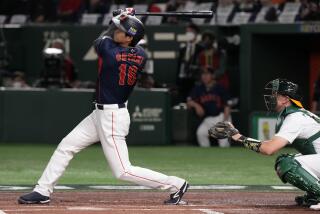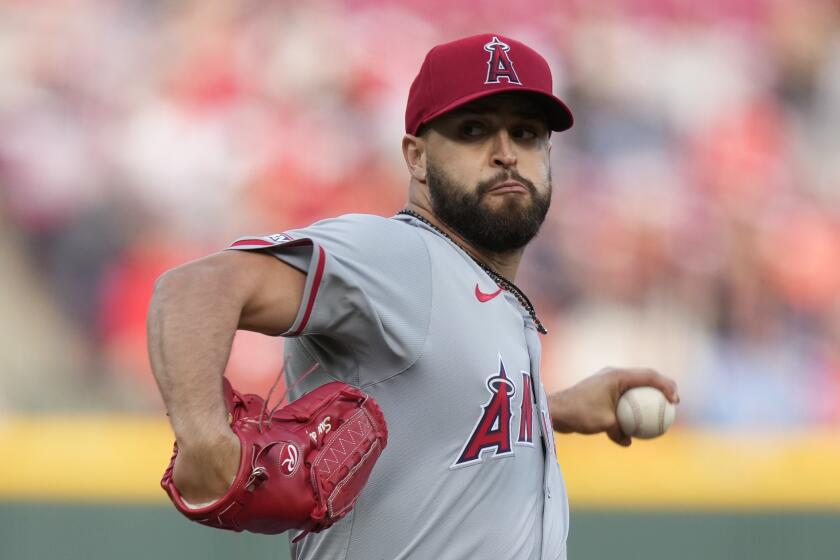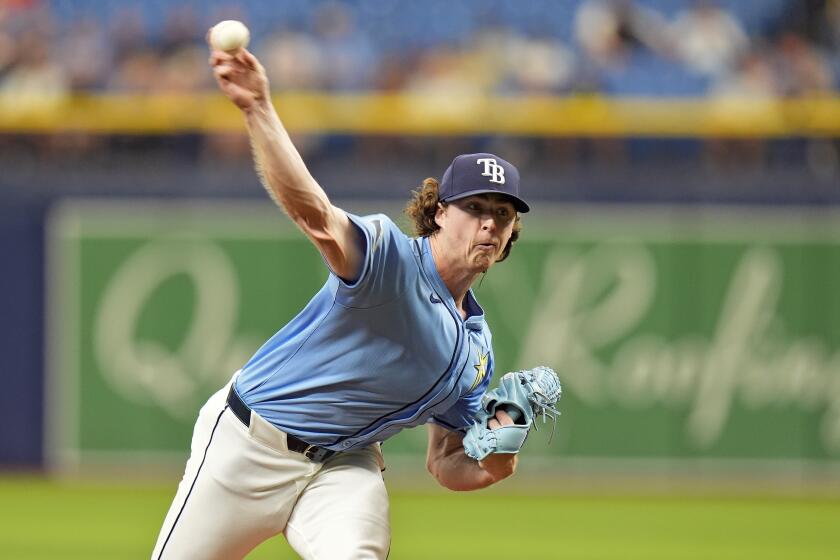Failure Wasn’t Supposed to Be Part of This Deal
In the three seasons since he was a Dodger, Chan Ho Park, by his own estimation, has lost the 97-mph fastball and the vanishing curveball.
What remains, other than the $29 million the Texas Rangers owe him over the next two years, is also left to his evaluation.
For the $36 million they have paid out so far, the Rangers have 14 wins, a familiar name on the disabled list, and mounds of frustration. They gave him the baseball for the 49th time Friday night in Seattle and hoped for something like assurance, something like proficiency, something like the guy they once signed out of Dodger Stadium who’d try so hard he’d practically have tears rolling down his face by the late innings. He gave up three runs in 5 2/3 innings against the Mariners, in a 9-6 loss.
“We’re being very blunt and very honest,” Ranger pitching coach Orel Hershiser said last week. “There’s no place left to protect him. For the Rangers, it’s been a very tough contract to swallow. Chan Ho, being a good kid, wants to live up to it.”
Two nights before that start, after turning in the kind of spring he needed to even remain in the Ranger rotation, Park mopped the effects of an hour-long workout from his neck and brow. If he was assured at the start of his 10th full big league season, if he believed he would be proficient, he hid it behind a shy grin and words almost too soft to hear.
The hamstring and back injuries that stunted his previous three seasons have subsided, but they appear to have left the sensitive, introspective pitcher with residual insecurities.
In Texas, he is considered a colossal bust, a financial burden, and another infuriating misstep by a historically pitching-thin organization, but necessary if the Rangers are to challenge the Angels in the American League West.
In Park’s introductory news conference, owner Tom Hicks announced that the Rangers had finally acquired a No. 1 starter, and there are those in the organization who believe Park, unaccustomed to such pressure, was finished at that moment. Others have cast the blame for Park’s failure on training modifications made by Ranger trainers and coaches, causing the hamstring injury that led to mechanical adjustments that resulted in chronic back pain. That was three years ago.
It is a lot to bear for a proud player, whose Dodger career started inauspiciously in a clubhouse in Chicago, where one chilly afternoon he would have fought every teammate after his new suit was slashed in a hazing incident, the value of which he did not comprehend.
“Three years is a long time,” said Park, who maintains an off-season condominium in Marina del Rey. “I expected it to be a great time in my life.”
He is willing to give the next two a chance. When Park arrived in Arizona for spring training, Ranger Manager Buck Showalter said he believed he saw something new, something that might have been familiar to anyone who saw Park win 75 games for the Dodgers from 1997 to 2001. Free from pain, assured perhaps that it could be controlled, Park wasn’t great but was around the plate again and pitched more innings than anyone else in Ranger camp. After considering releasing Park, Showalter and General Manager John Hart returned him to the rotation.
“I think he’s in as good a frame of mind as I’ve seen him since I’ve been here,” said Showalter, in his third season with the Rangers. “He’s had a lot of things to toughen up his skin.”
Asked to elaborate, Showalter said, “Well, you can compete or you can just walk away from it. He’s chosen to compete, and we respect that.”
Park will try his transition away from power pitcher at 31, young for a pitcher who has not had major arm surgery. His fastball sometimes won’t reach 90. His curveball sometimes won’t bite. It’s a lot to learn, more to accept.
“There was a time when he could embarrass hitters, strike them out,” Hershiser said. “Now, he has to go to a guy who knows the ball is going to where he wants it.”
According to Hershiser, Park spent the winter in Los Angeles, a place of good hardball recollections. An old Dodger guy himself, Hershiser said he suspected the months in L.A. soothed Park’s psyche and perhaps forced some uncomfortable self-analysis.
“I think he’s handled it very well, as hard as it’s been on him,” Hershiser said. “It’s hard enough to change organizations. Then it’s doubly hard not to perform well. It doesn’t matter who you are, you want to live up to the contract.
“At the beginning of the season, you want to be positive. For him, it’s about put up or shut up, not that he’s done any talking, but just to use a cliche. But it is time to produce. I’m sure he’s up to the challenge. Whether he’s sure or not, I don’t know.”
Park’s face remains that of the Dodger rookie, with the undeniable future at the top of someone’s rotation, armed with that endless fastball. His eyes, however, portend weariness, possessed by a man who has seen more than he has wanted.
“I’ll endure with my teammates,” he said. “That’s all. I’m looking forward. I learned from my past the last three years. It wasn’t easy. But it makes me a better person, a better player.”
He paused in the dugout, near the bottom step, poised to ascend to the playing field.
“I don’t expect to be who I was,” he said. “I expect to be who I am.”
Ultimately, the Rangers will decide whether that’s good enough. He was asked then whether his organization had been patient enough with him, through the injuries, through the failures.
He shrugged. “I guess,” he said, finally. “I’m still here.”
*
Plate umpires were correct on about 93% of their ball-strike calls last season, as determined by the QuesTec system installed at 10 major league ballparks, one at Angel Stadium.
Baseball official Bob Watson presented the QuesTec results to individual teams during spring-training meetings with individual coaching staffs.
There was, however, a substantial margin for error. Watson told coaches there had been a “buffer zone” of just less than a ball’s width on the vertical perimeters of the strike zone; a ball that passed through that area could be called either way -- ball or strike -- and the umpire would be graded as correct.
The technology is advertised as being equipped to accurately track pitches to within half an inch, and yet the umpires are allowed considerably more latitude. The buffer area at the top of the strike zone is 1 1/2 inches, and evaluators allow more leeway at the bottom, where pitches occasionally fall through the bottom of the strike zone near the front of the plate.
In its fifth season, and made infamous by infuriating Curt Schilling, Tom Glavine and a lot of umpires, the Umpire Information System survived the new five-year agreement reached by baseball and umpires in January.
Sandy Alderson, head of baseball operations for Major League Baseball, said umpires have largely conformed to the QuesTec virtual umpire, and the result is a more predictable strike zone. The umpires who consistently score below 90% accuracy are put on a track of education, in which improvement is required.
“We don’t want to scare them into excellence,” Alderson said. “That’s not our philosophy. For the most part, those who have had problems have responded favorably.”
*
Major League Baseball expects performance-enhancing drug-testing results from Florida minor leaguers in the next seven to 10 days. Last week, it suspended 38 minor leaguers in Arizona for spring training.... Wednesday night in Baltimore, Miguel Tejada faced Oakland reliever Huston Street. Tejada left the A’s after the 2003 season and signed with the Orioles for $72 million over six years. For losing Tejada, the A’s received a compensation pick, which they used to draft Street. Tejada singled to right.... Mariano Rivera, on Joe Torre’s message when he arrived at the mound in a disastrous ninth inning Wednesday against Boston: “He told me I was beautiful.” Since 2001, including postseason play, Rivera has blown 27 saves, 11 to the Red Sox.... David Wells to the Boston Globe: “I never in my lifetime ever thought that man would get booed walking off that mound. I was shocked. I felt bad for him.... Mo, he’s the best in the game, the best I’ve ever seen, in my time.” ... Jay Lucas, Dodger director of publicity from 1988 to ‘96, would be ideal to return as senior vice president of communications. His son and daughter recently returned to Southern California. Lucas holds the same position for the Houston Astros.
*
(BEGIN TEXT OF INFOBOX)
Wealth-Conscious
Chan Ho Park is the highest-paid Texas player. A look at the Ranger players making at least $1 million this season:
2005 RANGER MILLIONAIRES
RP Chan Ho Park...$15,000,000
2B Alfonso Soriano...$7,500,000
OF Richard Hidalgo...$5,000,000
RP Francisco Cordero...$3,875,000
1B Mark Teixeira...$3,625,000
LP Kenny Rogers...$3,338,758
SS Michael Young...$2,575,000
C Rod Barajas...$1,850,000
RP Carlos Almanzar...$1,100,000
OF Gary Matthews Jr....$1,100,000
RP Doug Brocail...$1,000,000
Park’s salary his last season with the Dodgers and his first three with the Rangers:
*--* 2001 Dodgers $9,900,000 2002 Rangers $6,884,803 2003 Rangers $13,000,000 2004 Rangers $14,000,000
*--*
More to Read
Go beyond the scoreboard
Get the latest on L.A.'s teams in the daily Sports Report newsletter.
You may occasionally receive promotional content from the Los Angeles Times.





